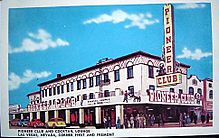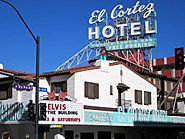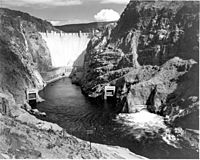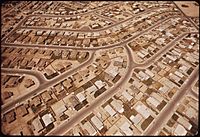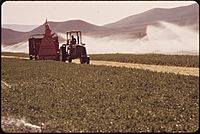Las Vegas in the 1940s facts for kids
Las Vegas in the 1940s was a really exciting time! The city grew a lot, and the famous Strip started to take shape. It was known for being friendly like the Wild West, but also full of glamor and fun.
In 1940, only about 8,400 people lived in Las Vegas. But in just five years, this number more than doubled! The whole Las Vegas Valley grew from about 13,937 people in 1940 to 35,000 in only two years.
Las Vegas in the Early 1940s
At the start of the 1940s, Las Vegas faced some challenges, including disagreements over who should lead the city.
A big change happened when the Army Gunnery School opened in 1941. This school, now called Nellis Air Force Base, trained many soldiers. Between 1941 and 1945, about 55,000 students learned there! The city of Henderson was also founded in 1941.
During World War II, the government spent a lot on defense. This meant more tourists came to Las Vegas. Many new buildings were built on streets like Fifth Street and Fremont Street, leading to the casinos. The city's layout also changed, expanding southwards. As casinos appeared on the Strip, other shops moved to Main Street and Commerce Street.
In 1940, the Clark Inn Motel and the Chief Hotel were built. During World War II, many wedding chapels, auto courts, and motels appeared on Las Vegas Boulevard.
A California hotel owner named Hull was invited to build a hotel with a casino. He chose a large site and built the El Rancho Las Vegas hotel in 1941. It had a big casino, restaurants, gardens, a swimming pool, and a huge parking lot. This hotel became a model for future casinos on The Strip.
In 1942, the famous actor Clark Gable was staying at the El Rancho when he heard that his wife, Carole Lombard, had died in a plane crash near Las Vegas.
Also in 1941, John Grayson opened the El Cortez Hotel and Casino. By December 1942, bars and casinos in Las Vegas closed for eight hours each night, starting at 2:00 AM.
The West Side Club opened for African American customers in the early 1940s. This was because, in 1942, city officials did not allow a hotel-casino that would serve both white and black customers in the Downtown area. The Hotel Last Frontier opened in 1942. Its Western Frontier Village included The Little Church of the West, where Betty Grable and Harry James got married in 1943.
By 1944, the Army base's training area grew very large. In that year, there was a disagreement between police and black soldiers who wanted to enter downtown bars and casinos. The Huntridge Theater was also built in 1944.
In 1940, women made up a small part of the workforce, with just over 1,000 working. Many worked in service, sales, or office jobs. However, during the 1940s, the number of working women increased a lot, showing their growing role in the city.
Las Vegas After the War (1945–49)
After World War II ended, Las Vegas celebrated! All the wartime rules were lifted, and tourism boomed.
In 1945, the Last Frontier hotel featured exciting dancing shows with chorus girls. One of these dancers later became the entertainment director for El Rancho Vegas.
The Nevada Power Company reported that its customers used 77 million kilowatt-hours of electricity in 1945. This amount more than doubled in just two years!
In December 1946, the Flamingo Hotel opened. The next year, the famous "Howdy, Pardner" city symbol, nicknamed Vegas Vic, was put up. In 1947, the Boulder Dam was officially renamed the Hoover Dam. By 1948, the Strip had several casinos, including the El Rancho, Last Frontier, Fabulous Flamingo, and Thunderbird.
As Las Vegas grew, it faced water shortages. In 1949, some faucets at the Las Vegas Hospital even ran dry. To help with this, the Nevada Natural Gas Company started planning a 144-mile natural gas pipeline from the city to Topock, Arizona. People realized that Lake Mead could be a solution for the city's growing water needs.
During World War II, Rockwell Field, which was Las Vegas's civilian airport, became a military base for the U.S. Army Air Corps. It was used as a training school. This airport was later named McCarran Airport, honoring Patrick McCarran, a U.S. senator from Nevada.
After the war, the military wanted to keep using McCarran Airport. So, a new civilian airport location was chosen at Alamo Field. Clark County bought this land. To help tourism grow, a new county airport was built. It opened on December 19, 1948. The stone pillars from the old McCarran Airport were moved to the new airport to honor McCarran.
City leaders also planned and built railroad underpasses. One was built in 1949 at West Charleston to help the city expand westward.


